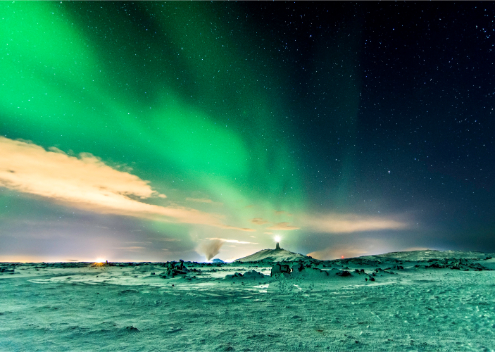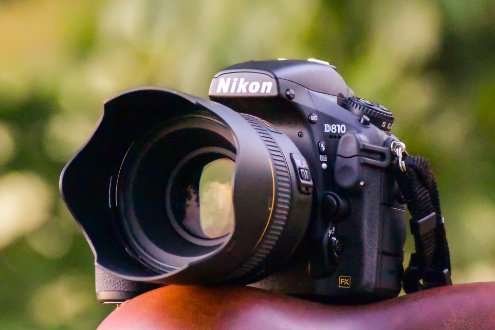If you’ve been watching the TV drama “His Dark Materials”, you’re likely to be familiar with the Aurora Borealis, more widely known as The Northern Lights, those elusive shimmering curtains of green and blue light which can be seen when you are within the Arctic Circle. At the moment, they seem to be on everyone’s bucket list. The closer you are to the north pole, the better the display will be. Fortunately, there are plenty of places to view this natural light show, from Norway, Finnish and Swedish Lapland, and Reykjavik in Iceland, to the other side of the Atlantic in Greenland and Canada - generally in countries which sit between 66°N and 69°N. For the best show, time your visit for the period from September to mid-April.
Iceland

Image Credit: Sean O Riordan
Iceland is one of the best countries to visit for a chance to see the Northern Lights. Although the "season" runs from September to April, you'll have more chances from October to March. That’s because the viewing conditions tend to be better, and the mountain peaks, intriguing basalt stacks, iridescent waterfalls, vivid blue glacial lagoons and wide-open skies make a great backdrop. At other times, the Iceland sky is just too light to see the Aurora. A great location from which to view the lights is Þingvellir (“Thingvellir”) National Park. For something a little different, take a boat trip from Reykjavík’s harbour and view the lights dancing above the ocean. This can be risky: not only do you need clear skies for the lights, but also calm seas. On windy days, they won’t take you out, but it won’t be a wasted trip – you’ll just be ushered out of the city on land instead.
Finland

Image Credit: Dave Grubb
In Finland, you can reach a higher latitude than in Iceland and, therefore, you can get better views of the Northern Lights. The best place is Finnish Lapland, where a night in a glass igloo or in a tree house, under the blazing Aurora, is definitely one to remember. Your best bet is to use the services of The Aurora Zone, the UK’s only dedicated Northern Lights holiday company. Three-night trips include return flights to Nellim in Finnish Lapland from London, transfers, full-board accommodation, cold-weather clothing and experienced guides. A range of activities (extra) can be added to the trip, including a reindeer farm visit, a husky safari and an Aurora snowmobile safari. The Aurora Zone is on 01670 785012.
Sweden

Image Credit: Azchael
Again, Lapland is the place to be for a good experience of the Northern Lights. Kiruna is the country’s northernmost city, with a population of around 17,000 people. It is the perfect base for exploring Sweden’s great white north. From Stockholm, you can either take a scenic 12-hour train ride or a 90-minute flight.
For the very best chance of seeing the Northern Lights, you should make the trip to the Aurora Sky Station in Abisko National Park. The national park is 100 km west of Kiruna, with daily shuttle transfers and accommodation offered at the STF Abisko Tourist Station.
Photographing the Northern Lights

Image Credit: Henry Söderlund
Be warned: It's surprisingly difficult to photograph the Northern Lights. Even though the aurora appears bright, its actual levels of illumination are quite low, so your smartphone, tablet or point-and-shoot camera are just not going to manage the job. It’s recommended that you use an SLR type camera. Here are some tips:
- Be warned: It's surprisingly difficult to photograph the Northern Lights. Even though the aurora appears bright, its actual levels of illumination are quite low, so your smartphone, tablet or point-and-shoot camera are just not going to manage the job. It’s recommended that you use an SLR type camera. Here are some tips:
- Take a tripod. You’ll need to shoot long exposures (see 5). You won't get away with resting your camera on a fence or somebody’s head; even the slightest movement will result in a blurry, disappointing photo. A cable release is also a great help
- Compose your picture properly! The scale of the aurora can be difficult to put over. Including a landmark in the foreground photo is a good way to lend the sky some perspective. Tilt your camera down and include a lake or building or other landscape feature
- You’ll need to use manual mode, because you must have full control if you want to photograph the lights; then you’ll be able to adjust the shutter speed, aperture and ISO
- Exposure time: Not too long, because you’ll just get a big green smudge. Five to ten seconds is enough to capture the detail if the aurora is bright and fast, up to twenty is perfect for one that’s slow, and thirty should be enough to capture even the faintest of glows
- Aperture: You’ll need as low an aperture as your lens allows to pick up the maximum amount of light – f/1.4 or f.2.8 are best
- ISO: You should start anywhere between ISO 400 and ISO 800, and increase as needed. If your photos are dark even with your lowest aperture and a slow shutter speed, you need to increase your ISO
Title Image Credit: Giuseppe Milo (Image Cropped)